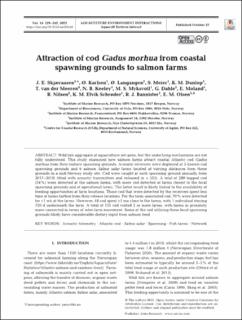| dc.contributor.author | Skjæraasen, Jon Egil | |
| dc.contributor.author | Karlsen, Ørjan | |
| dc.contributor.author | Langangen, Øystein Ole Gahr | |
| dc.contributor.author | Meier, Sonnich | |
| dc.contributor.author | Dunlop, Katherine Mary | |
| dc.contributor.author | van der Meeren, Terje | |
| dc.contributor.author | Keeley, Nigel B. | |
| dc.contributor.author | Myksvoll, Mari Skuggedal | |
| dc.contributor.author | Dahle, Geir | |
| dc.contributor.author | Moland, Even | |
| dc.contributor.author | Nilsen, Rune | |
| dc.contributor.author | Elvik, Kristine Marit Schrøder | |
| dc.contributor.author | Bannister, Raymond | |
| dc.contributor.author | Olsen, Esben Moland | |
| dc.date.accessioned | 2023-01-10T12:54:17Z | |
| dc.date.available | 2023-01-10T12:54:17Z | |
| dc.date.created | 2022-11-30T13:44:05Z | |
| dc.date.issued | 2022 | |
| dc.identifier.citation | Aquaculture Environment Interactions. 2022, 14 229-242. | |
| dc.identifier.issn | 1869-215X | |
| dc.identifier.uri | https://hdl.handle.net/11250/3042345 | |
| dc.description.abstract | Wild fish aggregate at aquaculture net-pens, but the underlying mechanisms are not fully understood. This study examined how salmon farms attract coastal Atlantic cod Gadus morhua from their inshore spawning grounds. Acoustic receivers were deployed at 5 known cod spawning grounds and 6 salmon Salmo salar farms located at varying distances from these grounds in a mid-Norway study site. Cod were caught at each spawning ground annually from 2017-2019, fitted with acoustic transmitters and released (n = 535). A total of 289 tagged cod (54%) were detected at the salmon farms, with more cod detected at farms closest to the focal spawning grounds and at operational farms. The latter result is likely linked to the availability of feeding opportunities at farm locations. Those cod that were detected by the receivers spent less time at farms farther from their release locations. For the farm-associated cod, 70% were detected for <1 wk at the farms. However, 48 cod spent >1 mo close to the farms, with 1 individual staying 720 d underneath the farm. A total of 135 cod visited 2 or more farms, with farms in proximity more connected in terms of inter-farm movement. Some of the cod utilizing these local spawning grounds likely have considerable dietary input from salmon feed. | |
| dc.language.iso | eng | |
| dc.title | Attraction of cod Gadus morhua from coastal spawning grounds to salmon farms | |
| dc.title.alternative | Attraction of cod Gadus morhua from coastal spawning grounds to salmon farms | |
| dc.type | Peer reviewed | |
| dc.type | Journal article | |
| dc.description.version | publishedVersion | |
| dc.description.version | publishedVersion | |
| dc.source.pagenumber | 229-242 | |
| dc.source.volume | 14 | |
| dc.source.journal | Aquaculture Environment Interactions | |
| dc.identifier.doi | 10.3354/aei00440 | |
| dc.identifier.cristin | 2085762 | |
| dc.relation.project | Fiskeri- og havbruksnæringens forskningsfinansiering: 901230 | |
| cristin.ispublished | true | |
| cristin.fulltext | original | |
| cristin.fulltext | original | |
| cristin.qualitycode | 1 | |

